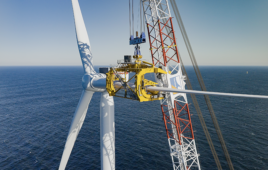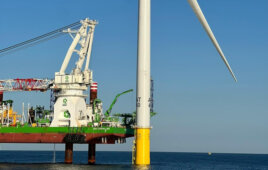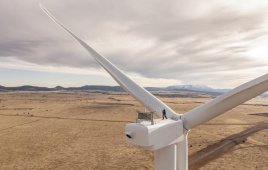Of all the mechanical maintenance problems in wind turbines, shaft alignments are probably easiest to understand. The high-speed shaft between a gearbox and generator is a critical point of failure. Their misalignment a leading cause.
Precision-shaft alignments involve aligning the center line of the shafts of one or more rotating machines. When the shaft center lines are co-linear, the two turn freely mitigating external forces that could destroy key components of the system, such as bearings, seals, and couplings. Misalignment most affects the main bearings in the gearbox and generator. When left unattended for too long, it will destroy the bearings and then go to work on other components down the line on the shaft – seals, rotors, and so on.
A precision shaft alignment at install and periodic checks can help prevent component failures, up-tower repairs, and catastrophic failures. For instance, fixing a bearing up tower can cost $10,000 to $15,000. Catastrophic failures can cost up to $260,000. A good alignment program can stop these problems before they even start.
Alignments are done with several tools, some better than others. For instance:
Straight-edge mechanical tools
• Do not provide a precision alignment and are
• Subject to gross user interpretation
Dial indicators
• Must be mounted on the shafts
• Time consuming for the inexperienced
• Difficult to learn a proper alignment method
• Shafts must turn to align with dials
• Subject to user interpretations
Laser alignment tools have
• A short learning curve
• Precision, even from inexperienced users
• Many mounting options for different turbines
• Shafts need not turn
• No interpretation by the user. The data is
the data
Precision alignment means using a laser alignment kit or dial indicators. (A straight edge is not a precision alignment tool.) Lasers have many advantages over dial indicators. For one, dials are hard to teach and learn. Until you have mastered the art of dial indicators, they can be frustrating and time consuming. Lasers, on the other hand, are a fast, easy, and accurate when used to align shafts.
Good laser-alignment tools have options for mounting in wind turbines. Different brands of turbines present different challenges. For instance, the position of the brake calipers and discs can prevent mounting with a chain and bracket on the shaft. When the shaft turns for alignment work, the measuring units (laser and detectors) must turn without obstruction. Hence, mounting options must take those clearances into consideration. Lastly, a proper alignment job is not complete without a good electronic method for documentation.
Condition monitoring can help detect alignment problems. Vibration-monitoring tools for example, look at the mechanical components such as bearings and gears, but they also helps identify the root cause of an existing problem and predict component failure. Condition monitoring can detect misalignment problems before they damage mechanical components. Angular misalignment, for instance shows in the vibration spectrum in the axial direction, typically showing high vibration at 1x or 2x turning speed. Offset misalignment more typically shows up in a radial measurement, when the vibration signal at 2x turning speed is greater than at 1x.
The increase in vibration at twice running speed in the spectrum shows a misalignment condition that is worsening and causing damage. Using vibration to detect a misalignment problem and a laser shaft-alignment tool for correction, prevents serious mechanical issues.
Consider several issues when aligning wind turbine shafts. Safety is first and foremost. Laser alignment tools must be mounted in such a way that they will not contact the techs if the turbine brakes give way. Turning the shafts is critical to performing a precision alignment. O&M teams working up-tower must be aware of conditions that result in turning the blades, and hence, the shafts. Taking a measurement without turning the shaft is becoming a more predominant requirement. Still, a sudden strong gust of wind can catch the maintenance team off guard and cause the shaft to spin freely as the brakes are released for the alignment.
Some turbine manufacturers have developed solutions for alignment work that do not require turning the gearbox. These solutions require special fixtures and removing the coupling to perform the alignment. However, it is the safest way to perform an alignment in a wind turbine. Know the guidelines that your turbine OEM has set for up-tower alignments, such as maximum wind speed and direction the turbine should face. Also ask: Can the shaft covers be off or on and should the coupling be removed? Make sure your maintenance teams are safety trained as well.
A second consideration is deciding how often to align the turbine. Many turbine OEM’s have set requirements for turbine alignment intervals. Some OEM’s only align prior to shipment from the manufacturing facility. Others align when the turbine arrives “in-country”, or during installation. Some do all three. It is never a bad idea to check turbine alignment. Include a precision alignment check during intervals of preventative maintenance. You can even check the alignment fairly quickly when it is not scheduled. Once you determine that an alignment is required, you can schedule it in your maintenance plan.
Another important consideration: Alignment tolerances. These define an acceptable misalignment for a given turbine model. Many turbine OEMs have established alignment tolerances for their equipment. If you don’t know the manufacturer’s tolerances, or they are not supplied, tolerance charts are available based on speed of rotation.
A last thing to consider for this article is dynamic movement. This happens when the brake is released and the hub and blades turn freely. Weight and turning forces can cause the gearbox to move slightly – even imperceptibly to the human eye – and cause misalignment. Consult your turbine manufacturer to find out if dynamic movement is present in their turbines, if they know how much it moves, and whether or not it is critical. In some cases, the coupling can offset the movement when the shafts are aligned within tolerance. Once you know the amount of movement, add those calculations to an alignment tool. Compensating for dynamic movement means actually misaligning the gearbox and generator at rest so that when they are running, the machines will move into alignment.
Lasers are also used in the wind industry to measure flanges on wind towers and blade-root flanges. Flatness and taper measurements help ensure that these components fit properly during construction.
Precision alignment is a vital first step in preventing mechanical failure in wind turbines. whether the OEM, an O&M contractor, or an O&M team performs the alignment, good tools and training are not optional. Remember, an ounce of prevention is worth a pound of cure, and prevention lessens the chance for catastrophic, up-tower, machine failure. WPE
Filed Under: Components








This information is very helpful. How ever in our current problem in the wind farm we conduct alignment while the rotor is locked. We remove the coupling so that we can place our alignment tools. While the rotor is locked and alignment was corrected, however when we rotate the generator shafting the is a big misalignment in the shaft outside the tolerance limit, but as I consult the supervisor he said it is just normal. But for me I think that is not normal.
Thanks for the info. I’m currently training to become a Wind Turbine Technician through MIAT in Canton MI, and am looking forward to becoming a part of the industry. Just curious if you know of any apprenticeships or entry level positions specializing in (or emphasizing) Wind Turbine drivetrain alignment. If there are I’d be interested. Thanks